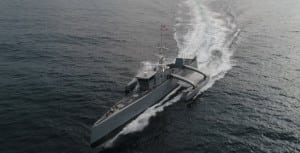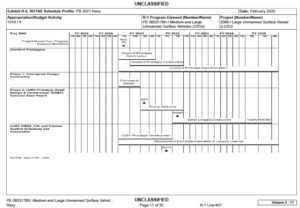The Navy’s FY 2021 budget request explains a new acquisition plan for the Large Unmanned Surface Vehicle (LUSV), pushing back the first vessel to FY ‘26.
Congress pushed back on the Navy’s plans in the FY ’20 budget request, which planned for a new 10-ship LUSV fleet starting with $400 million for two Ghost Fleet/Overlord-style vessels that year, followed by two new LUSVs per year through FY ’24. The total program cost through vessel 10 would be $2.7 billion.

Congress said some of the work was early to the need and funded the two prototype LUSVs but prevented the service from installing vertical launch tubes (VLSs) as planned on the vessels for now. The Navy planned to buy the first two LUSVs.
In the wake of Congress’ skepticism, last month Rear Adm. Casey Moton, program executive officer for unmanned and small combatants, said the Navy was now making schedule adjustments (Defense Daily, Jan. 16).
The budget request is now asking for $239 million in research and development funds in FY ’21 and expects to request $377 million in FY ’22, $145 million in FY ‘23, $199 million in FY ‘24, and $135 million in FY ’25. Over the Future Years Defense Program (FYDP) it plans to spend about $1.1 billion total.
Compared to the FY ’20 request, the FY ’21 plan now expects to award conceptual design (CD) contracts to multiple vendors in the fourth quarter of FY ’20, rather than the second quarter to amending the CD request for proposals.
This will “support refinement of a LUSV Performance Specification that does not include the Vertical Launch System (VLS). The final Performance Specification will define a LUSV with reservations in the design to support integration of a variety of capabilities and payloads,” the documents said.
This CD delay will also delay follow-on activities like request for proposals and source selection leading up to the LUSV’s detail design and construction (DD&C) contract. DD&C award will be delayed from FY ’21 to FY ’22 and will deliver a LUSV prototype without the VLS.
The Navy noted that now instead of awarding the LUSV DD&C contract in FY ‘21, it plans to procure up to two more Overlord prototypes, building on the lessons learned from the Ghost Fleet program.
The Navy plans to only transition LUSV into a program of record in FY ’23 when it will join the main shipbuilding and conversion funding account.
In the new plan in FY ‘20 the Navy will buy the funded two Ghost Fleet/ Overlord prototypes to be delivered in FY ‘21 “to mitigate technical risk and continue to generate lessons learned through testing and experimentation.” The Navy will also award multiple CD contracts for a LUSV with reservations to integrate future payloads, which will help inform the final performance specifications.
In FY ’21 the Navy plans to buy two more Overlord prototypes to build on overlord lessons learned, use modular payloads, platforms for more systems, and refine concepts of operations, including manned/unmanned teaming.

That year the Navy will also release a request for proposals for a full and open DD&C contract for the full LUSV, with an FY ’22 award for a single prototype LUSV, also with reservations to integrate future payloads.
In FY ’23 and beyond the service plans to act on contract options to produce LUSVs with the Integrated Combat System (ICS) and VLS using regular shipbuilding appropriations.
In total, over the FYDP the service plans to procure 10 LUSVs: two Overlord prototypes and one LUSV prototype via research and development funds, two LUSVs with ICS and VLS annually from FY ’23-’24, and three LUSVs in FY ’25.
The Navy’s budget justification documents explained the LUSV “will be delivered and fielded initially as research and development prototype vessels (Overlord prototypes and one prototype LUSV) intended to demonstrate successful integration of government furnished Command, Control, Communications, Computers and Intelligence (C4I) and combat systems and the reliability of automated hull, mechanical, and electrical (HM&E) systems.”
The document noted the prototype LUSVs will incorporate reservations in the design for future combat capabilities, hoping to transition to procure and deliver a LUSV with an “integrated combat system and organic payloads supporting Anti-Surface Warfare (ASuW) and Strike mission areas.”
The justification document said other potential LUSV capabilities will be informed by the service’s Future Surface Combatant Analysis of Alternatives and be refined as future payloads and concepts of operation are developed.